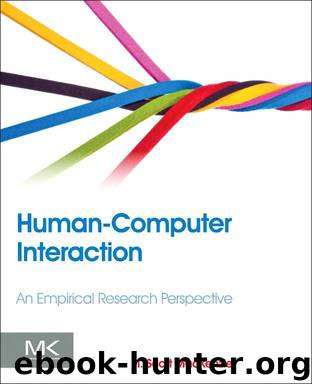Human-Computer Interaction by I. Scott MacKenzie

Author:I. Scott MacKenzie
Language: eng
Format: epub
ISBN: 9780124071650
Publisher: Elsevier Inc.
Published: 2013-01-02T16:00:00+00:00
5.7 Task and procedure
Let’s revisit the definition of an independent variable: “a circumstance or characteristic that is manipulated or systematically controlled to elicit a change in a human response while the user is interacting with a computer.” Emphasis is added to “elicit a change in a human response.” When participants are given a test condition, they are asked to do a task while their performance is measured. Later, they are given a different test condition—another level of the independent variable—and asked to do the task again. Clearly, the choice of task is important.
There are two objectives in designing a good task: represent and discriminate. A good task is representative of the activities people do with the interface. A task that is similar to actual or expected usage will improve the external validity of the research–the ability to generalize results to other people and other situations. A good task is also one that can discriminate the test conditions. Obviously, there is something in the interaction that differentiates the test conditions, otherwise there is no research to conduct. A good task must attune to the points of differentiation in order to elicit behavioral responses that expose benefits or problems among the test conditions. This should surface as a difference in the measured responses across the test conditions. A difference might occur if the interfaces or interaction techniques are sufficiently distinct in the way the task is performed.
Often, the choice of a task is self-evident. If the research idea is a graphical method for inserting functions in a spreadsheet, a good task is inserting functions into a spreadsheet—using the graphical method versus the traditional typing method. If the research idea is an auditory feedback technique while programming a GPS device, a good task is programming a destination in a GPS device—aided with auditory feedback versus visual feedback.
Making a task representative of actual usage will improve external validity, but there is a downside. The more representative the task, the more the task is likely to include behaviors not directly related to the interface or interaction method under test. Such behaviors are likely to compromise the ability of the task to discriminate among the test conditions. There is nothing sinister in this. It is simply a reflection of the complex way humans go about their business while using computers. When we enter text, we also think about what to enter. We might pause, think, enter something, think again, change our minds, delete something, enter some more, and so on. This is actual usage. If the research goal is to evaluate a new text entry method, a task that mimics actual usage is fraught with problems. Actual usage includes secondary tasks—lots of them. If the task involves, for example, measuring text entry speed in words per minute, the measurement is seriously compromised if tasks unrelated to the entry method are present.
While using a task that is representative of actual usage may improve external validity, the downside is a decrease in internal validity. Recall that high internal validity means the effects observed (i.
Download
This site does not store any files on its server. We only index and link to content provided by other sites. Please contact the content providers to delete copyright contents if any and email us, we'll remove relevant links or contents immediately.
| Content Management | Programming |
| User Experience & Usability | User Generated Content |
| Web Design | Web Marketing |
| Web Services | Website Analytics |
The Mikado Method by Ola Ellnestam Daniel Brolund(11877)
Hello! Python by Anthony Briggs(11791)
Dependency Injection in .NET by Mark Seemann(11001)
The Well-Grounded Java Developer by Benjamin J. Evans Martijn Verburg(9420)
Sass and Compass in Action by Wynn Netherland Nathan Weizenbaum Chris Eppstein Brandon Mathis(8808)
Secrets of the JavaScript Ninja by John Resig Bear Bibeault(8594)
Svelte with Test-Driven Development by Daniel Irvine(8085)
Test-Driven Development with PHP 8 by Rainier Sarabia(7840)
Layered Design for Ruby on Rails Applications by Dementyev Vladimir;(7652)
Secrets of the JavaScript Ninja by John Resig & Bear Bibeault(7408)
Kotlin in Action by Dmitry Jemerov(7263)
Web Development with Django by Ben Shaw Saurabh Badhwar(7151)
React Application Architecture for Production by Alan Alickovic(6847)
Jquery UI in Action : Master the concepts Of Jquery UI: A Step By Step Approach by ANMOL GOYAL(6447)
Software Architecture for Web Developers by Mihaela Roxana Ghidersa(4948)
Audition by Ryu Murakami(4850)
Accelerating Server-Side Development with Fastify by Manuel Spigolon Maksim Sinik & Matteo Collina(4805)
Solidity Programming Essentials by Ritesh Modi(4529)
Hands-On Full-Stack Web Development with GraphQL and React by Sebastian Grebe(4412)
